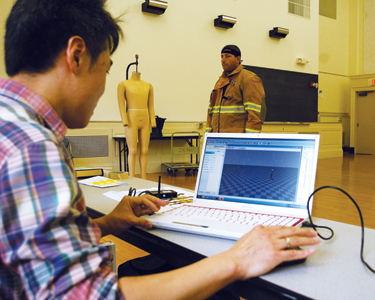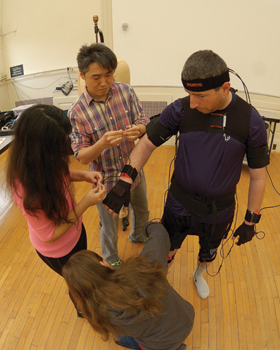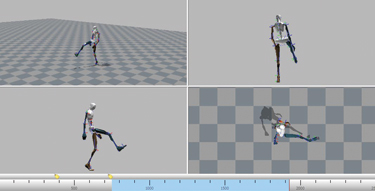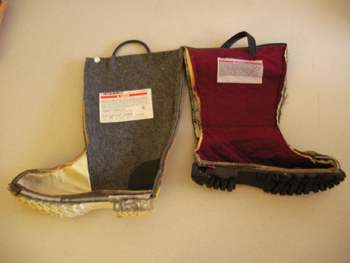Bob Galvin
The personal protective equipment (PPE) that firefighters don to fight fires can be as much of a deadly health risk as the fires themselves. That’s the opinion of Huiju Park, assistant professor in the department of fiber science and apparel design at Cornell University in Ithaca, New York. Why is the professor so concerned? While a doctoral student at Oklahoma State University in Stillwater, Oklahoma, Park became well acquainted with firefighters there as part of research he was conducting on issues tied to the fire safety gear they wear. “I realized what they were wearing is what they were issued by their fire department and that it was their only protection,” Park recalls. “I felt it was important to research how to improve this gear for responders’ safety and their work efficiency.”
 |
|
(1) Huiju Park, Cornell University professor of fiber science and
|
Better-Fitting PPE the Goal
Park’s research continued when he joined the College of Human Ecology at Cornell University, where he is overseeing a study on how using 3D motion-capture technology can reveal how PPE might be improved to fit more comfortably and allow movement more freely. Specifically, Park is the principal investigator on a project in which he has engaged graduate and undergraduate students in his “Functional Aspects of Clothing Design” class to examine how poor-fitting boots cause ankle sprains, then to use 3D imaging to record subtle changes in balance, foot comfort, and joint movement. The 3D imaging involves placing paper-thin sensors inside fire boot footwear to capture dynamic in-shoe pressure information unseen by the naked eye. The information captured with the sensors reveals interaction between foot and footwear. The plantar pressure sensors also quantify force, contact pressure distribution, and timing.
Park’s research received firefighters’ input from focus groups and surveys. He aims to develop new performance and design guidelines for PPE as part of a larger study with University at Buffalo and Colorado State University researchers.
Also, Park found that many female firefighters have difficulty finding coats and pants that fit.
The study will delve further, however, to uncover how firefighters’ movements can be more comfortable and natural by designing better-fitting protective gear. The study is part of a five-year multistate research project that is financed with a federal formula grant. The federal government uses formula grants to distribute billions of dollars annually to state and local governments to assist with projects in areas such as health, transportation, and education. In addition to funding for the Cornell University study, Honeywell First Responder Products has donated 30 pairs of rubber and leather fire boots for Park’s project.
 |
|
(2) Park and his students attach motion sensor gear
|
Older Firefighters at Risk
As Park delved into his study, he was surprised to learn that more than 60 to 70 percent of U.S. firefighters are volunteers. What’s more, a majority of volunteer firefighters are in their 40s and 50s. “This means they are much more vulnerable to any kinds of injuries when working in dangerous conditions,” Park notes. “This is why the research I’m doing is important. I also noticed a majority of on-duty injuries are musculoskeletal injuries, such as ankle sprains on slippery and unstable firegrounds,” the professor added.
PPE for years has been designed to provide protection from fire and burn injuries. But, it is hardly perfect-or injury proof-and burn injuries are one of the most feared and major types of injuries. “A large pool of statistics and literature shows that many firefighters die from cardiovascular malfunction, such as heart attack with heatstroke,” Park reveals. “It comes from overexhaustion, mental stress, and heatstroke working in extremely dangerous conditions.”
 |
|
(3) Park’s team has analyzed the range of motion at each joint for eight male
|
Response Time a Factor
Some other statistics, although unrelated to Park’s study, show why his observations are not a complete surprise. For instance, the Fire Equipment Manufacturers’ Association (FEMA) currently notes on its Web site that 93 percent of deaths and 95 percent of property damage occur once the fire has progressed beyond the early stage-in which the first few minutes of a fire are critical. Once first responders arrive at an incident, the fire is already well underway and temperatures are soaring. Another statistic on the FEMA Web site indicates that typically, fire departments are three to five minutes away from arriving at an incident scene, but that volunteer fire departments can experience up to a 15-minute wait to respond. The longer the response time, the larger and hotter the fire becomes, making response efforts extremely dangerous and life threatening.
Firefighter Thermal Stress Linked to PPE
A February 2008 study titled “Emergency Incident Rehabilitation,” produced by the United States Fire Administration (USFA), discusses stress-related injuries and deaths in the fire service. The study acknowledges the dangers of firefighting and emergency scene operations, with special concern regarding the risk to personal safety. “Though firefighters spend a considerable amount of time training to deal with the physical hazards, in truth, the most credible hazard that firefighters face is the stress that their job places upon their own bodies,” the study said. Most pointedly, thermal stress was cited as the chief cause of 3,555 injuries occurring on the fireground in 2005. The study indicated the most likely place for a thermal injury to occur is on the fireground, adding, “This is most likely due to the heavy protective gear worn by firefighters during these operations, the amount of strenuous activity being performed while wearing this gear, and the heat generated by the incident itself.” Finally, the study states that “firefighters who are overstressed and physically expended are at a greater risk for suffering a heart attack or stroke.”
 |
|
(4) This screen capture demonstrates how a firefighter’s movements
|
Mobility, Agility
The USFA’s findings underscore Park’s present research, which was given some validation when he held a focus group of about ten firefighters this past summer. He learned that the main challenge firefighters experience every day is mobility. “It is necessary to have a certain range of bulkiness (in the safety gear) to protect firefighters from burn injuries because having protective layers with air gaps is really important for providing thermal protection,” Park said. Still, it’s important to remember that, unlike cold environments, extremely hot ones like those found on the fireground can prompt safety gear to dramatically increase the body’s temperature. “That’s a big reason that cardiovascular malfunction is the number one reason for firefighters’ death on duty; it’s closely related to a sharp increase in body temperature and heart rate,” Park says. Therefore, while having sufficient thermal insulation is good for protection, it also has a negative impact on body temperature and cardiovascular function. Why? Because even though the gear originally was designed to give thermal protection, it also negatively affects the thermal regulatory function of the body (promoting a rise in body temperature), Park continues.
For these reasons, Park has concluded that improving firefighting gear design features for better mobility can slow down the increase in body temperature by reducing the physiological risks. “That’s how I started this research,” Park says.
Extensive research already has been completed on firefighter range of motion while wearing protective gear and on agility. Other research has focused on the physiological impact of boot wear on firefighters’ performance by measuring energy expenditure. “My study is a bit unique because I’m focusing on the biomechanic (structure and function of biological systems, such as humans) impact of fire protective gear and its performance,” Park asserts. “I’m also using the latest technology in motion capture so that I can record body performance over time,” he adds. “This is different from previous studies.” In a way, Park’s study can be somewhat likened to sports biomechanics, where the laws of mechanics are applied to learn about athletic performance and to reduce sports injuries as well.
 |
|
(5) Park’s study involves placing paper-thin sensors inside fire
|
Informing Manufacturers
So far, Park’s team has analyzed the range of motion at each joint for eight male and four female firefighters, along with the pressure applied inside their boots. They have studied ways the body is impacted by wearing protective gear to understand what leads to poor balance and inefficient movement. The upshot of the study’s findings will be to propose better design suggestions for protective gear. “I will publish my findings in relevant journals,” Park says, “because I need to establish validity for this study.” The professor’s ultimate goal is to collaborate with PPE makers on his data and develop new design ideas.
BOB GALVIN is a freelance writer who writes on issues, trends, and topics related to prefire planning practices. He has had numerous articles regarding the need for prefire planning published in fire industry publications.

